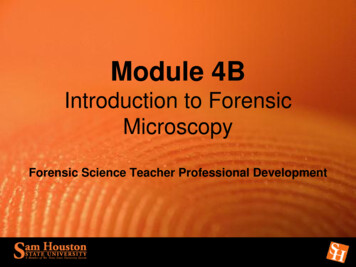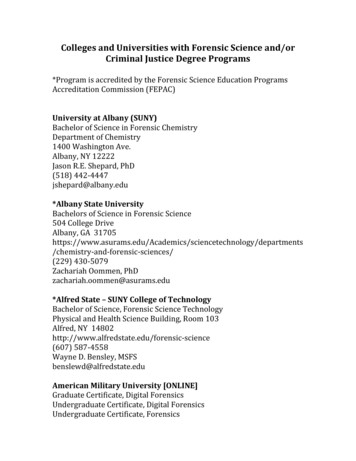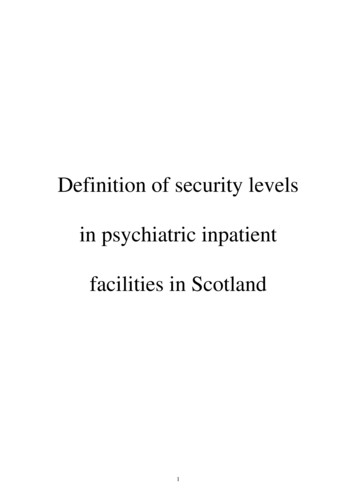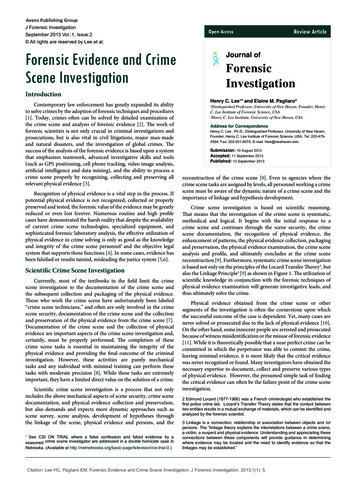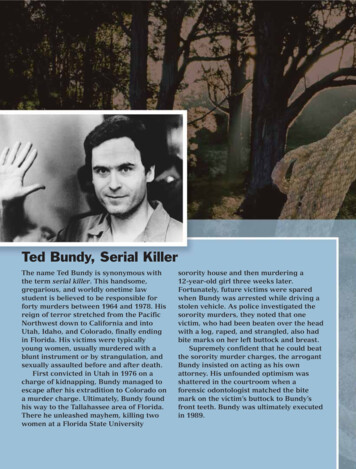
Transcription
Forensic Sciences:A Crime Scene Investigation Unitfor Senior 3 Current Topics in the Sciences
ContentsCONTENTSIntroduction 5Rationale 5Integrating the Sciences 6Planning the Forensic Sciences Unit 7Linking to Specific Learning Outcomes (SLOs)Establishing a Crime Scene 16Instructional Overview 19Assessment 21Crime Scene Kit 22Crime Lab Equipment 22Essential Understanding 1: Blood AnalysisActivity 1a: Blood Typing Analysis 25Activity 1b: Blood Spatter Analysis 291123Essential Understanding 2: Forensic Anthropology—Bone AnalysisActivity 2a: Height Analysis 35Activity 2b: Searching for the Romanovs 39Essential Understanding 3: Chromatography 45Activity 3: The Colour of Guilt—Chromatography3347Essential Understanding 4: Decomposition 53Activity 4a: Forensic Entomology Research AssignmentActivity 4b: A Bug’s Tale 59Essential Understanding 5: DNA Profiling 65Activity 5a: Extracting DNA from Onion Cells 69Activity 5b: DNA Fingerprinting—Bar Code SimulationActivity 5c: DNA Fingerprinting—Electrophoresis 79Essential Understanding 6: Fingerprinting (Dactyloscopy)Activity 6: Fingerprinting 85557383Essential Understanding 7: Physical Evidence—Fibre, Stain, and Hair AnalysisActivity 7a: Fibre and Stain Analysis 91Activity 7b: Hair Analysis 9589Essential Understanding 8: Handwriting Analysis 99Activity 8: The Science of Handwriting Analysis? 101Contents – 3
Forensic Sciences: A Crime Scene Investigation UnitEssential Understanding 9: Chemical DetectionActivity 9: Chemical Detection 107Essential Understanding 10: Soil AnalysisActivity 10: The Dirty Truth 115Essential Understanding 11: Urine AnalysisActivity 11: Urine Analysis 123105113121Essential Understanding 12: Enrichment and Extensions—Further AnalysesFinal Forensic Sciences Performance Task: Sample Crime SceneStudent Self-Reflection on the Forensic Sciences UnitResources 141Print Resources 141Online Resources 1424 – Contents140133131
IntroductionINTRODUCTIONI never guess. It is a shocking habit—destructive to the logical faculty. Whatseems strange to you is only so because you do not follow my train of thought orobserve the small facts upon which large inferences may depend.Sherlock Holmes, The Sign of FourForensic Sciences: A Crime Scene Investigation Unit for Senior 3 Current Topics in the Sciencescontains suggested essential understandings and possible activities, assignments, investigations,and assessment ideas for curriculum implementation. What is included here is by no meansexhaustive or restrictive; nor is it expected that all suggested activities will be used. Theessential understandings are not arranged in order of importance or priority, and may beaddressed in any order that produces a coherent sequence. Teachers decide which essentialunderstandings will allow them to address the specific learning outcomes that frame Senior 3Current Topics in the Sciences.Teachers are encouraged to choose from this selection of suggested content, activities,investigations, and assignments, of varying levels of difficulty, and to develop the unit further byusing some of their own content and activities. Many online and print resources are available tosupplement the treatment of Forensic Sciences in the classroom. (See the Resources cited at theend of this unit.)RationaleSolving mysteries is a challenge many people enjoy. If they take a scientific approach, they arelikely to use forensic sciences to examine evidence and to solve crimes. Students are commonlyexposed to crime situations in the media, both fictional and real, and are likely aware thatforensic sciences are used to solve crimes, as many current television programs and popularauthors use the science of forensics to develop their dramas. However, students may not beaware of the methodology used by law enforcement personnel. By becoming involved in asimulated crime scene, students will see how forensic investigators apply scientific skills andprocesses in a problem-solving capacity.A forensics team is a group of scientists who work together performing different jobs to solvecrimes or to identify people. A forensics team may observe the crime scene and gather evidencesuch as hair and fibre samples, fingerprints, and tissue samples. An investigative team includesforensic scientists with varying areas of expertise, including toxicology, forensic biology,forensic entomology, chemistry, forensic psychology, forensic odontology, forensicanthropology, bloodstain pattern analysis, and weapons specialists. The job of forensicinvestigators is to use science and technology to perform tests on the evidence collected. Theresults from these tests can then be used to support a theory of guilt or innocence.Forensic scientists use the same instruments and techniques used by scientists doing other typesof research, including microscopes, computers, gas chromatographs, and lasers. As science hasadvanced, so has the ability to gather evidence and to solve crimes. At crime scenes, portablelasers provide special lighting. Imaging technology lets a police officer instantly send aphotograph or fingerprint image to a central data bank for identification. Computers can enhancepictures taken by a security camera at a crime scene. New chemicals allow the visualization ofotherwise unseen fingerprints. Lasers can vaporize tiny portions of a paint specimen todetermine the exact paint used on a car in a hit-and-run case. A single cell can providedeoxyribonucleic acid (DNA) that molecular biology techniques can match with a suspect.Introduction – 5
Forensic Sciences: A Crime Scene Investigation UnitThe Forensic Sciences unit was developed to allow students to integrate a number of scientificdisciplines and to practise a variety of scientific skills and processes, including makingcomparisons, classifications, observations, measurements, and predictions, as well as formulatinghypotheses, manipulating variables, and interpreting data. The unit consists of individualactivities, each of which includes teacher and student pages. The unit can be designed to includeany activities teachers (or students) may wish to incorporate into their forensics learningexperience.The student learning activities are highly variable, and can be structured and sequencedaccording to student interest, available materials, and local resources. Solving a crime requiresthe use of critical thinking skills that will integrate several science disciplines and be usefulacross the curriculum.Integrating the SciencesAs students explore the topic of forensic sciences, many sciences may naturally be integrated.The following table outlines suggested essential understandings and their possible connections tothe major science disciplines. It is important to recognize, and reinforce with students, that it iscommon for diverse specialties to operate simultaneously in scientific investigation.Essential Understandings6 – IntroductionNumberEssentialUnderstanding1Blood Analysis Blood typing2ForensicAnthropology—Bone Analysis DNA Bones3Chromatography4Decomposition5DNA Stain, and HairAnalysis8HandwritingAnalysis9Chemical Detection10Soil Analysis11Urine Analysis12Further AnalysesBiologyChemistry ChemicalreactionsPhysicsGeo-Sciences Blood spatteranalysis Solubility Entomology Life cycles DNA Soil Chemicalextraction Physicalcharacteristics Properties Chemicalreactions Soilcharacteristics Kidneyfunction Disease Chemicalreactions
IntroductionPlanning the Forensic Sciences UnitA unit plan evolves from a particular topic. A number of essential understandings within thearea of interest could be generated either by the teacher alone or with the help of students.Essential understandings are concepts, skills, or bodies of knowledge that are crucial forstudents to comprehend to develop an in-depth understanding of the topic. The essentialunderstandings will likely determine the specific learning outcomes (SLOs) for generallearning outcome (GLO) D (Essential Concepts).The number of essential understandings generated will depend upon the topic, the amount oftime allotted to the unit, and the interest of students. There may be essential understandingsof particular interest to students that develop during the presentation of the unit, andteachers are encouraged to pursue these. While the size of a unit may vary (for example, 10to more than 50 hours), teachers are encouraged to pursue a depth of treatment that ismanageable and connected to the SLOs identified for the Senior 3 Current Topics in theSciences curriculum. (Teachers implemented the Draft version of the Forensic Sciences unitwith timelines spanning 25 to 65 hours.)In developing the Forensic Sciences unit, teachers may choose to use planning tools such asthe Unit Development Concept Map (with possible essential questions) or the UnitDevelopment Using Essential Understandings Approach shown in the samples andtemplates that follow. Teachers involved in field validation work found these planning toolsuseful.Note: There may be more or fewer than eight essential understandings. The arrows serve to connect essential understandings to thetopic.Introduction – 7
Note: There may be more or fewer than eight understandings. The arrows serve to connect essential understandings to the topic.Forensic Sciences: A Crime Scene Investigation Unit8 – Introduction
IntroductionIntroduction – 9
Forensic Sciences: A Crime Scene Investigation Unit10 – Introduction
IntroductionLinking to Specific Learning OutcomesAfter developing the initial unit plan, teachers may use an SLO Tracking Chart to linkinstructional strategies and student learning activities to the specific learning outcomes(SLOs).A single unit will not necessarily address all SLOs. The SLOs are cumulative in nature, andit is expected that a student will have the opportunity to achieve all outcomes by the end ofSenior 3 Current Topics in the Sciences.An SLO Tracking Chart will assist teachers in determining whether each SLO has beenaddressed at least once during curriculum implementation. Many SLOs will be addressedmore than once by virtue of the design of interdisciplinary units.The following SLO Tracking Chart is an example of a specific learning outcome audit for aset of student learning activities in a Forensic Sciences unit. A template of the SLO TrackingChart follows the sample.Introduction – 11
Forensic Sciences: A Crime Scene Investigation Unit(continued)12 – Introduction
IntroductionNote: This chart is intended to highlight how student learning activities connect to the learning outcomes. It is not a comprehensivetreatment of all activities in the sample Forensics Sciences unit.Introduction – 13
Forensic Sciences: A Crime Scene Investigation Unit14 – Introduction
IntroductionIntroduction – 15
Forensic Sciences: A Crime Scene Investigation UnitEstablishing a Crime SceneThe LocationChoose an area with limited access to students, such as a storage area or an extra room atschool, so that the crime scene can remain set up for continued observations. You may alsochoose to have the crime scene take place at another location (such as close to a pond),leaving evidence (such as soil, vegetation, and/or insects) indicating the area associated withthe body found at the crime scene.StorylineDetermine the victim(s) and suspect(s) and their relationship(s) to each other (if one can beestablished). Establish a scenario where all suspects have the motive, opportunity, andmeans to be involved in the crime, but the outcome is undetermined in advance. It is hopedthat students will manage the evidence.SuspectsOnce you have established a group (about five) of suspects, decide whether to introducethem in written form or to have individuals (teachers) act out the roles. Each suspect shouldhave the motive, opportunity, and means to be involved in the crime. Trace evidence maylink a number of different suspects to the crime scene. Motive: A motive is a reason for committing the crime. Possible motives are passion,jealousy, greed, and revenge. Motive is usually determined through interviews andresearch. Opportunity: A suspect who can be placed at the scene of the crime, or was able to getto the scene of the crime within a certain time frame, can be said to have hadopportunity. Means: A suspect considered by investigators to have been able to commit the crimecan be said to have had means.As an extension, you may want to add a witness or suspect who has been seen fleeing thecrime scene.AlibisEstablish alibis for some or all of the suspects (some alibis may be false). This informationmay be presented to students in written form, as in a police interview with the suspect. Asthe investigation proceeds, the suspect(s) might be subjected to several interviews wherethey might add new information and/or change their stories. You might choose to distributeinformation from the interviews at specific intervals. You might also provide your suspectswith a written script and allow the forensic investigative teams to interview the suspects.Suspect FilesYou may wish to establish “suspect files” within the class, to which information can beadded during the course of the investigation.16 – Introduction
IntroductionEvidenceEvidence is any statement or material object from which reasonable conclusions can bedrawn. It is a broad category embracing anything perceptible to the five senses, includingdocuments, exhibits, facts agreed to by both sides, and the testimony of witnesses. Evidencein a criminal trial concerns the intent, motive, means, and opportunity to commit a crime.In general, evidence is divided into two categories: circumstantial and physical. Circumstantial evidence consists of information gleaned from witnesses anddocuments that point to an individual as the perpetrator of a crime. Physical evidence consists of actual objects, bodies, weapons, body-fluid stains,fingerprints, hairs, fibres, and so on, that are associated with the crime and may belinked to the perpetrator.It is the work of forensic scientists to examine the physical evidence and, using the methodsof science, to reconstruct the events that constituted the crime. The prosecutor must thencombine this data with statements of witnesses and evidence from documents, such ascorrespondence, telephone records, and credit card receipts, to develop an overall theory ofthe case, which can be presented in court.Crime Scene DetailsEstablish crime scene details such as the following: If possible, mark off the crime scene using police or yellow tape (Crime Scene—DoNot Cross). For the body, use a skeleton, a large doll, clothes stuffed with paper and a mask head, orsimply an outline of the body marked with tape or chalk on the floor. Plant “trace” evidence at the crime scene (see Planting Evidence at the Crime Scene onthe following page). Leave it all at once or control the gathering of evidence by leavinga few items at a time and having students return to the crime scene to gather more.Creating a tabular format sheet to track evidence will be useful in providing linkages topossible suspects. Consider leaving some red herrings as well, such as cigarette butts, empty cans,earrings, or candy wrappers.Use a table such as the following to map out the types of evidence you plant at the crimescene and the suspect to whom it links.Introduction – 17
Forensic Sciences: A Crime Scene Investigation UnitVictimSuspect ASuspect BSuspect CSuspect DSuspect E18 – /Foot LengthBlood SpatterEvidenceBlood TypingPlanting Evidence at the Crime Scene
IntroductionCollecting and Storing EvidenceGreat care must be taken in collecting, labelling, and preserving any evidence connectedwith a crime. The police must be able to prove that the evidence has always been in theirpossession from the time it was taken at the crime scene until the time it appears in court.Anyone who has access to the material must be documented. Police must prove that theobject shown in court is the same object that was tested in the laboratory. If this cannot beproven, the judge may rule that the chain of custody has been broken and the object maynot be admitted into evidence. As soon as an object is found, it is placed in a container,sealed, and labelled. The place where the object was found and when it was found are notedby the officer who also initials the label. When the evidence goes to the police station orforensic lab, it is placed in a locked evidence room to which only a few people have access.An exact record is maintained of everyone who has had the evidence in his or herpossession.For the Forensic Sciences unit, you may wish to make the following preparations: Provide students with gloves for collecting evidence. Use zippered plastic bags to store evidence gathered at the crime scene and from thesuspects. Label bags with a code (such as Exhibit # 17-34067) for which you maintainthe key, or with the suspect’s name and address. Prepare a box labelled Evidence Locker. Investigative teams must sign out the evidencestored in this box before examining it (providing exhibit number, date, and signature).Forensic Investigation Lab BookThe information collected by the forensic investigative teams may be written up in aforensic database or in a Forensic Investigation Lab Book. You may wish to have individualteam members initial their work to ensure that each member is contributing to theinvestigation. You may choose to allow them access to this information at any time, evenduring a quiz or final examination. Students are encouraged to keep their database or labbooks neat and to organize the information in a manner that allows them to retrieveinformation quickly.Instructional OverviewAn overview of the steps and processes involved in the Forensic Sciences unit follows:1. Establish Forensic Investigative TeamsTeams research the various types of forensic investigation specialties, and individualteam members choose to be specialists in particular fields.2. Introduce the CrimeDescribe the crime to students and provide the teams with some initial investigativereports.3. Organize the Forensic Investigation Lab BookStudents begin to organize the format of their lab books.4. Create Evidence BoardsStudents may also display their evidence in flow charts on evidence boards. These mayremain set up on the classroom wall.Introduction – 19
Forensic Sciences: A Crime Scene Investigation Unit5. Consider Using Introductory ActivitiesYou may choose to have students engage in introductory observational and logicalthinking activities such as the following: Students solve mathematical problems involving logic. Students form two lines of pairs facing each other for 30 seconds. Students in oneline then turn away, and the students in the other line change one thing about theirappearance (for example, untie shoe, remove earring, flip hair). The students in thefirst line then turn back and determine what is different. Someone runs quickly (and without warning) through the room. Students describethe individual.6. Document the Crime SceneInvestigative teams observe the crime scene. They make diagrams with referencepoints, photographs, or videos.7. Gather EvidenceStudents gather and bag evidence, either all at once or at intervals during theprogression of the unit. You may also choose to provide students with writteninformation, such as witness interviews, police reports, and newspaper reports.8. ResearchStudents research various aspects of the case, including the history of the developmentof specific analyses.9. Analyze the EvidenceStudents examine the evidence from the crime scene and compare it to samples fromsuspects.10. Prepare Investigation ReportStudents write a summary report of their investigation, which includes a description ofwhat they think happened, with evidence to support this scenario. Explain how physicalevidence collected at the scene of a crime could be used to assist in an arrest andconviction of a suspect.11. Tie Together All the Evidence/ReportingProvide various opportunities for students to examine evidence and data gathered in thecrime scene investigation and to make conclusions based on the findings.a. Hold a Mock TrialStudents may engage in a mock trial, assuming the various roles: judge jury accused defence team prosecution team witnesses expert witnesses20 – Introduction
IntroductionThe evidence should be examined thoroughly, and all data questioned and analyzed.Conclusions must be related to actual evidence. The division of duties could includethe opening argument, closing statement, presentation of each type of technicalevidence, direct examination, and cross-examination. Students assigned to the jurywill hear the case and then deliberate before the class. This will allow all students tohave a speaking role.b. Write and Present a Fictional Crime Scene DramaGroups of students (preferably re-mixed from their investigative teams) write andpresent a crime scene drama. The evidence should be examined thoroughly, and alldata questioned and analyzed. Conclusions must be related to actual evidence.c. Write and Present a Fictional Crime Scene Short StoryStudents (groups or individuals) write a fictional crime scene story. The evidenceshould be examined thoroughly, and all data questioned and analyzed. Conclusionsmust be related to actual evidence.d. Prepare News ReportsStudents (groups or individuals) write a series of news reports (fact or fiction) basedon a crime scene investigation. The evidence should be examined thoroughly, and alldata questioned and analyzed. Conclusions must be related to actual evidence.AssessmentAssessment strategies may include the following: lab reports daily log of investigative team’s activities Forensic Investigation Lab Book— research notes— crime scene notes— diagrams— lab investigations— summaries— conclusions evidence summary and conclusions presentation final reportIntroduction – 21
Forensic Sciences: A Crime Scene Investigation UnitCrime Scene KitCriminal investigators use a variety of materials and instruments in collecting evidencefrom a crime scene. These materials may include the following: crime scene tape string chalk measuring tools hand-held magnifying glass coloured evidence flags flashlight adhesive lint pick-up roller tweezers swabsportable alternative light source(infrared, ultraviolet, laser) tape lifts trace evidence vacuumfingerprinting kit (powder, brushes,lifting tape, cards, stamp/ink pad) sketchpad, logbook, pen cameracasting kit (casting powder, mixingbowl, fixative)—for tire prints orfootprints video recorder laser trajectory kit evidence bags gunshot residue kit seals paper bags envelopesblood-detection reagents(phenolphthalein, leucomalachite,luminol) disposable clothing serology kit gloves insect specimen jars masks “hazmat” (hazardous materials) kit—toassess composition of toxic materialsCrime Lab EquipmentCrime labs may include equipment such as the following: beakers spectrograph flasks spectrometer burets spectrophotometer pipets electron microscope graduated cylinders ultraviolet lighting test tubes gas chromatograph watch glasses mass spectrometer stereoscopic microscopes electrophoresis chamber compound microscopes nuclear reactor phase contrast microscopes refractometer spectroscope liquid chromatography apparatus22 – Introduction
Essential Understanding 1 Blood AnalysisESSENTIAL UNDERSTANDING 1:BLOOD ANALYSISTeacher BackgroundBlood consists of a solid portion (red blood cells, white blood cells, platelets) suspended in awatery plasma. Many chemicals are also suspended or dissolved in the plasma, includingproteins, sugars, fats, salts, enzymes, and gases.One way in which blood may be characterized is by the presence or absence of moleculeslocated on the surfaces of the red blood cells. In the ABO blood typing group, there are twotypes of chemical molecules or antigens found on the red blood cells: A and B. If a red blood cell has only A antigens on it, it is type A. If the red blood cell has only B antigens on it, it is type B. If the red blood cell has both A and B antigens on it, it is type AB. If neither A nor B antigens are on the surface, it is type O.If two different blood types are mixed together, the blood cells may clump together in theblood vessels, with potentially fatal results. Blood types must be matched before bloodtransfusions take place. Type A blood groups produce antibodies against B antigens and, hence, can accept onlytype A or type O blood in a blood transfusion. Type B blood groups produce antibodies against A antigens and, hence, can accept onlytype B or type O blood in a blood transfusion. Type AB blood groups produce neither anti-A nor anti-B antibodies and, hence, canaccept type AB, type A, type B, or type O blood in a blood transfusion. Type O blood groups produce both anti-A and Anti-B antibodies and, hence, can acceptonly type O blood in a blood transfusion.Because of these patterns, a person with type O blood is said to be a universal donor. Aperson with type AB blood is said to be a universal receiver. In general, however, it is stillbest to mix blood of matching types and Rh factors. Rh (rhesus) factor refers to the presence(Rh ) or absence (Rh-) of the D antigen on the surface of the blood cell.Response of Blood Types to AntiseraBloodTypeAntigen(Surface Molecule)AntibodyProducedAgglutination withAnti-A SerumAgglutination withAnti-B SerumAAAnti-BYesNoBBAnti-ANoYesABA and BNoneYesYesONoneAnti-A and Anti-BNoNoBlood Analysis—Reference: Sinclair, Thea. “Forensic Lab Activity—Blood Analysis.” A Case of Murder: AForensic Science Unit, 19 April 2005 157theasinclair/Heading5.html .Blood Analysis – 23
Forensic Sciences: A Crime Scene Investigation UnitSuggestions for InstructionThe following concepts could be developed in this section: blood typing chemical reactions Implement a prior knowledge strategy, such as a Concept Map or a KWL (Know, Wantto Know, Learned) strategy (see SYSTH 9.6-9.14), to activate students’ prior knowledgeand recognize entry-level misconceptions. Once concepts have been examined in class, use a Concept Organizer Frame (seeSYSTH 11.23-11.25) to help students develop an understanding of the concepts.Suggested Student Activities Activity 1a: Blood Typing Analysis Activity 1b: Blood Spatter Analysis* SYSTH refers to Senior Years Science Teachers’ Handbook (Manitoba Education and Training).24 – Essential Understanding 1
Essential Understanding 1 Blood AnalysisActivity 1aTeacher NotesBlood Typing AnalysisSpecific Learning OutcomesSLO A1Distinguish critically between science and technology in terms of their respectivecontexts, goals, methods, products, and values.SLO A4Recognize that science and technology interact and evolve, often advancing oneanother.SLO B3Identify the factors that affect health and explain the relationships of personal habits,lifestyle choices, and human health, both individual and social.SLO C1Demonstrate appropriate scientific inquiry skills, attitudes, and practices when seekinganswers to questions.SLO D1Use the concepts of similarity and diversity for organizing our experiences with the world.OverviewThe Blood Typing Analysis activity involves the study of the ABO blood groups usingsimulated blood and antisera. Adaptations may be made to include the Rh factor.Setting the Crime SceneLeave vials of simulated blood (preparation instructions follow) or blood spots/spatter(ketchup or costume blood) at the crime scene (see also Activity 1b: Blood SpatterAnalysis). Blood may belong to the victim and/or suspect(s). Students may either interviewsubjects to determine blood types, or ask for “samples” of their blood.To determine whether a spot is actually blood, students can first drop hydrogen peroxide ona dried smear of beef blood using a prepared microscope slide (provided by investigatorsfrom the crime scene). Students must wear gloves when handling the blood slides. Realblood bubbles when a drop of hydrogen peroxide is placed on it. This reaction is due to thepresence of the enzyme catalase in mammalian blood. This test works even after the bloodis dried. Note that ketchup, oil stains, coffee, and tobacco juice will not cause hydrogenperoxide to bubble, and could be used to confuse the crime scene.Materials simulated A, B, AB, and O blood simulated anti-A and anti-B sera spot plate toothpicks unknown blood samples (prepared by teacher) blood evidence gathered at crime scene reagents: calcium chloride, barium chloride, sodium carbonate, ammonium carbonateBlood Analysis – 25
Forensic Sciences: A Crime Scene Investigation UnitBlood typing kits may be purchased from a scientific supply company. Simulated blood andantisera may be prepared as described below:Preparing the A, B, AB, and O BloodTo four vials, each containing 100 ml water, add the following: Type A — 6 g CaCl2 Type B — 2.5 g BaCl2 Type AB — 6 g CaCl2 and 2.5 g BaCl2 Type O — nothing (water only)To each solution, add about 25 ml of 25 per cent Congo Red. (This may be varied.) Preparethe unknowns and blood evidence using the same method.Preparing the Antisera Anti-A — 100 ml 0.1 M Na2CO3and 1 drop of blue food colouring Anti-B — 100 ml 0.2 M (NH4)2CO3 and 1 drop of yellow food colouringProcedurePart 1: Observing the Reactions of Known Blood Samples with AntiseraThe ABO blood typing system and chemical reactions/precipitation may need to beintroduced or reviewed. Students then use simulated blood and antisera (precipitation ofchemical solutions) to examine the different blood types. Care must be taken to ensure thatequipment is clean.Part 2: Identifying the Blood Types of Unknown Samples (Practice)For practice, students use the procedure from Part 1 to identify the blood types of unknownsamples.Part 3: Identifying the Blood Evidence Gathere
forensic scientists with varying areas of expertise, including toxicology, forensic biology, forensic entomology, chemistry, forensic psychology, forensic odontology, forensic anthropology, bloodstain pattern analysis, and weapons specialists. The job of forensic investigators is to use science



